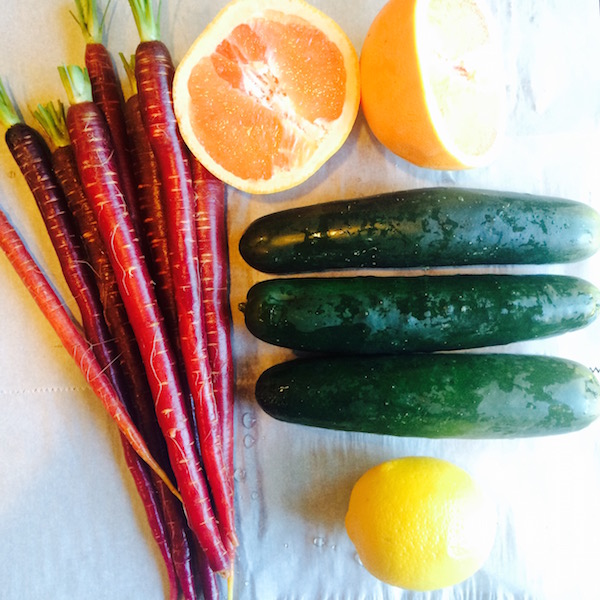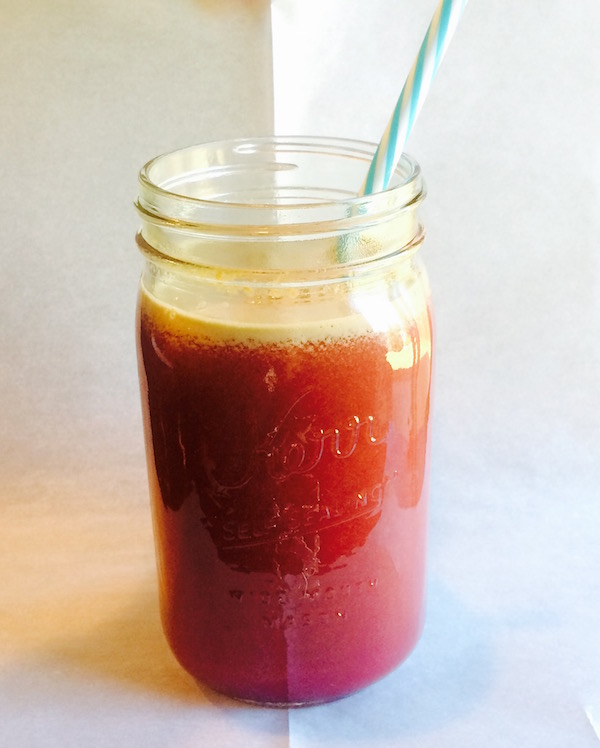There are a couple of basic guidelines to follow in order to get the most benefit from juicing. Here they are:
[1] Juicing fruit is not as beneficial as juicing vegetables. Using too much fruit will increase the amount of sugar you’re consuming. Yes, it’s natural sugar, but sugar is sugar is sugar.
[2] It’s best to consume fresh juice on an empty stomach or between meals. Because juicing removes the fiber from the whole fruit or vegetable, you are going to absorb the nutrients quickly [fiber slows digestion]. And if you drink your juice with a meal that contains protein, fiber and/or fat, this will also slow digestion + absorption. So drinking fresh juice outside of meals will ensure efficient absorption of all those health boosting nutrients.
[3] You’ll get the most nutrients from your juice if you drink it right away. Juicing and then leaving it in the fridge for a day or two is almost counterproductive. Once juiced, the vegetables + fruit will begin lose their nutritional value, leaving you with less of the benefits. So try and either drink your juice right away or at least within a few hours of juicing.
[4] Variety is important. If you’re a regular juicer, it’s important to change up the fruits and veggies that you’re using in order to get a variety of nutrients, rather than the same ones over and over again. Your body thrives on variety. Each fruit + vegetable on this earth contain varying levels of vitamins, mineral, phytonutrients, etc. and for different reasons. If you’re an occasional juicer it’s okay to stick with just one of your favorite recipes; just be sure you are eating a variety of whole vegetables throughout the day in addition.
Grapefruit-Carrot-Cucumber Juice. Let’s talk nutrients.

What’s grapefruit good for?
The grapefruit is a large citrus fruit similar to oranges. There are a couple of different varieties that come with flesh that is either white, pink or ruby red. Grapefruits are juicy, tart and just a tad sweet. Go for the pink grapefruit for the sweetest flavor. While grapefruit can make a great addition to your diet, beware of the many medications that interact negatively with grapefruit such as some cholesterol lowering and high blood pressure meds.
Grapefruit [and other citrus fruits] are a great source of vitamin C! Vitamin C is most known for it’s ability to keep your immune system strong. It is also an inflammation and free radical fighter, meaning that it can prevent free radical damage and help fend off or help prevent many inflammatory conditions which we see cropping up everywhere, from arthritis to heart disease.
Grapefruit are also a great source of the phytonutrient [plant nutrient] lycopene, which give the grapefruit their pinkish-red pigment. Lycopene is another free radical squashing nutrients which means it’s a great inflammation fighter!
The many health benefits of carrots.
Carrots come in a variety of colors with a variety of nutrients. They are a great source of antioxidants and a rich source of vitamin A. The popular orange carrots are high in beta-carotene which gives them their vibrant orange color. Purple carrots are high in anthocyanins, giving them their pretty purple complexion. And yellow carrots are a great source of the phytonutrient lutein which is great for eye health! Overall, consumption of carrots [in any variety] has been shown to have many anti-inflammatory benefits. Add carrots to soups, salads, smoothies, stir-frys juices or munch on them for an afternoon snack. There’s really no bad way to eat a carrot.
Eat your cucumbers.
Cucumbers are super versatile “vegetables” that contain lots of water and nutrients, and little calories. Technically, cucumbers are actually a fruit but we’ve come to know these delicious, juicy beauties as vegetables, and there’s nothing wrong with that. I love adding them to juice because they can provide a lot of volume with so few calories + sugar. As with many vegetables, cucumbers are also high in antioxidants, making them anti-inflammatory. So eat your cucumbers by adding them to salads, sandwiches, munching on them for an afternoon snack, adding them to water and juicing them with your favorite fruits and veggies.

Need a juicer? This is the one that I use and love! Check it out here.
Grapefruit Carrot Cucumber Juice
servings: about 2 16-oz. portions
INGREDIENTS*
- about 8 organic carrots [any variety will do – I used purple carrots in this recipe]
- 1 grapefruit, peeled
- 3 organic cucumbers
- 1 lemon, peeled
*Please use only organic ingredients when juicing. This will ensure you are consuming the cleanest, most nutritious fruits + veggies.
DIRECTIONS
Wash all produce thoroughly before juicing. Add all ingredients to juicer and enjoy!
* you can juice your ingredients in any order.

- about 8 organic carrots [any variety will do - I used purple carrots in this recipe]
- 1 grapefruit, peeled
- 3 organic cucumbers
- 1 lemon, peeled
- *Please use only organic ingredients when juicing. This will ensure you are consuming the cleanest, most nutritious fruits + veggies.
- Wash all produce thoroughly before juicing. Add all ingredients to juicer and enjoy!
- You can juice your ingredients in any order.
Did you try this juice? Let me know what you thought in the comments below! What are some of your favorite juicing combinations?






This is delicious! Very refreshing.
So glad you loved it! Thanks for the comment 🙂
Wow! really amazing fruit recipe. Nice blog, thanks for sharing such an awesome recipe.
Thanks for the comment! I’m so glad you loved the recipe as much as I do! 🙂